John Tolley, May 1, 2018
It is estimated that in an hour, the Sun blankets the Earth in more energy than the whole of humanity uses in a year. Some of that energy, of course, is reflected away, some blocked by clouds, but even if we could capture a fraction of it, we could greatly decrease our dependence on fossil fuels.
Solar panels are popping up everywhere, as people are beginning to grasp our collective need for clean, renewable sources of power for our daily lives. But there is a big problem with most current models: they are made from large, inflexible sheets of silicon and are costly to produce.
However, a new method of producing thin, carbon-based photovoltaics, developed by researchers at the University of Michigan, could mean more solar energy capturing surfaces, even in our clothes.
Speaking with the University of Michigan News Service, lead researcher Stephen Forrest, the Peter A. Franken Distinguished University Professor of Engineering and Paul G. Goebel Professor of Engineering, said that these ?organic? solar panels could lead to a ?truly ubiquitous clean energy source.?
Testing has shown that the solar panels operate at 15-percent efficiency, a number that matches commercially available models. The researchers have also predicted that the panels, over their lifetime, could produce energy at a cheaper than average price per kilowatt/hour.
To learn more about this work and about how the University of Michigan is committed to finding working solutions to global energy problems, check out the full article here.







